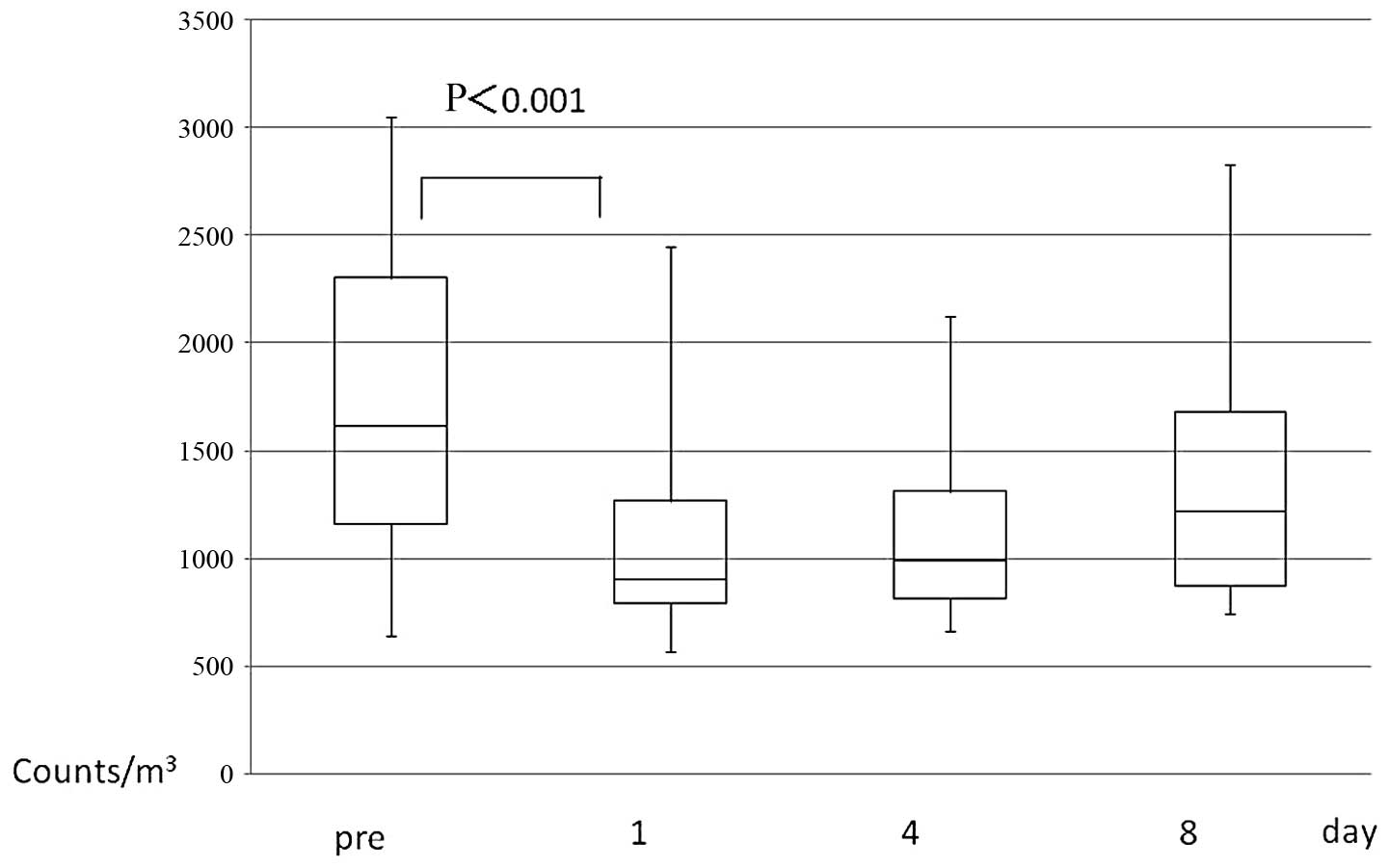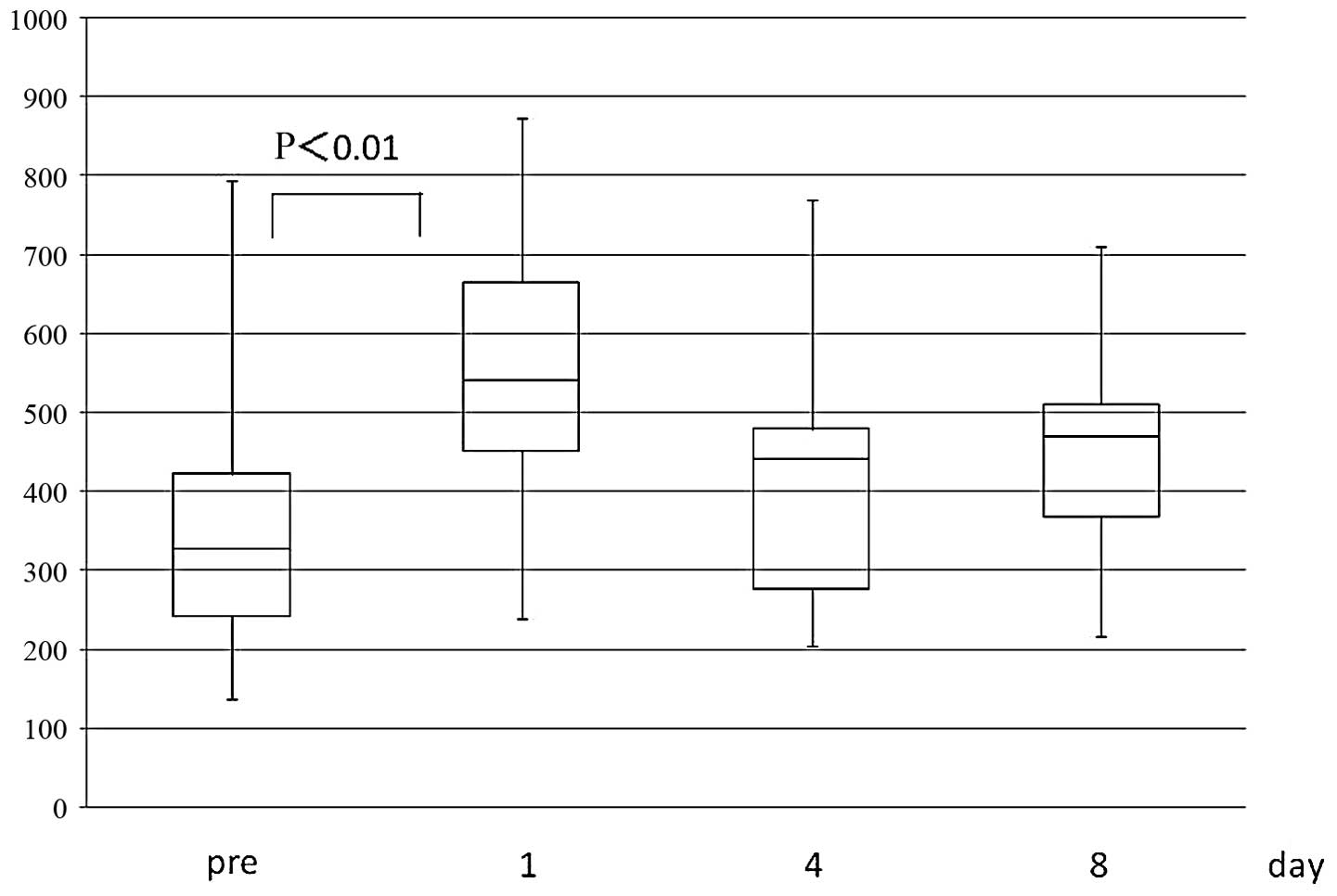CD4+ T‑lymphocytes are activated by surgical stress following colorectal resection in cancer patients
- Authors:
- Published online on: October 13, 2014 https://doi.org/10.3892/mco.2014.442
- Pages: 79-82
Abstract
Introduction
The immune cell function assay (ImmuKnow; Cylex, Inc., Columbia, MD, USA), which enables the measurement of the CD4+ T-cell activity, was approved for use by the US Food and Drug Administration in 2002 (1). To date, a number of studies (2–5) have investigated the correlation between the immune response and rejection in transplant recipients since Hooper et al (5) established immune response zones using the ImmuKnow assay in 2005. Those studies demonstrated that low adenosine triphosphate (ATP) levels in CD4+ T cells are associated with increased risk of infection. In addition, it was suggested that monitoring using the ImmuKnow assay may reflect the dynamics of the immune status (4).
In contrast to transplantation, surgical stress induces postoperative immunosuppression, which has been evaluated by measuring interleukin (IL), cortisol and C-reactive protein (CRP) levels and/or the CD4+ T-cell count (6, 7). By contrast, Wu et al (8) reported the reference of CRP, IL-6, IL-8 and HLA-DR levels, but not the CD4/CD8 ratio between laparoscopic and conventional surgery for colon cancer and concluded that the extent of surgical trauma may affect those results. However, these parameters have not been proven sufficient to evaluate the postoperative immune status. Therefore, it is necessary to identify a novel parameter that may be used to accurately evaluate the immune status in postoperative patients.
To the best of our knowledge, there are currently no available studies evaluating the extent of surgical stress by assessing the ATP levels of CD4+ T cells. The aim of this study was to measure ATP levels in CD4+ T cells as a marker of T-cell activity in the acute phase following colorectal surgery using the ImmuKnow assay. We investigated the dynamics of postoperative ATP levels and compared these levels between laparoscopic and conventional open abdominal surgery as an endpoint in this study.
Patients and methods
Patients
A total of 16 consecutive patients with colorectal cancer who underwent surgery at the Department of Gastroenterological Surgery at Fukuoka University Hospital between August and December, 2012 were included in the present study. Patients who had received immunosuppressive drugs or steroids and underwent organ transplantation were excluded. Our sample included 13 men (81.2%) and 3 women (18.8%), with a mean age of 62.4 years (range, 41–84 years). The diagnosis was based on radiological examinations and histological confirmation for staging information. The clinicopathological characteristics of the patients are summarized in Table I. Pathological staging was performed based on the TNM classification of malignant tumors, 7th edition, published by the Union for International Cancer Control (9).
The present study was approved by the Medical Ethics Board of Fukuoka University, Faculty of Medicine (no. 12-6-15) and all the patients provided written informed consent prior to enrolment.
ImmuKnow assay
Whole-blood samples from the colon cancer patients were collected using sodium heparin anticoagulant tubes. The ImmuKnow assay was performed according to the manufacturer's protocol. In brief, the blood samples were diluted using sample diluents and incubated for 15–18 h with phytochemagglutinin-L-containing cell lysate at 37°C, in a 5% CO2 incubator. Following incubation, the CD4+ T cells were collected using magnetic particles coated with anti-human CD4 monoclonal antibodies. Following rinsing, the intracellular ATP released by cell lysis was measured using luciferin/luciferase and a luminometer (Tristar LB941; Berthold Technologies GmbH, Bad Wildbad, Germany). The ATP level was calculated in nanograms per milliliter. The ImmuKnow assay was performed in quadruplicates preoperatively and on postoperative days 1, 4 and 8.
Statistical analysis
The correlations between the ImmuKnow assay data and the clinicopathological parameters were statistically analyzed. In addition, the blood laboratory data were examined on the same days as the ImmuKnow assay and these values were investigated for a correlation with the ImmuKnow data. The statistical analysis was performed by paired t-test using JMP Statistical Discovery software (SAS Institute Inc., Cary, NC, USA) and P<0.05 was considered to indicate a statistically significant difference.
Results
TNM staging
According to the TNM classification, 7th edition, 7 patients had stage I, 5 had stage II, 2 had stage IIIb and the remaining 2 had stage IV disease (Table I).
White blood cell (WBC) count
Open abdominal surgery and laparoscopic resection were performed in 9 and 7 patients, respectively (Table I). The WBC count was significantly increased on the 1st postoperative day [mean preoperative vs. 1st postoperative day level ± standard deviation (SD): 5,318.8±1,453.8 vs. 9,087.5±2,5878.6, respectively; P<0.001], followed by a gradual return to the baseline preoperative levels (Fig. 1).
CRP
The CRP level (mg/dl) was aberrantly high on the 1st postoperative day (mean preoperative vs. 1st postoperative day level ± SD: 0.27±0.55 vs. 5.91±2.95, respectively; P<0.0001) and the 4th postoperative day, but decreased to normal by the 8th day (Fig. 2).
Lymphocyte count
The lymphocyte count decreased significantly on the 1st postoperative day (mean preoperative vs. 1st postoperative day level ± SD: 1,740.7±758.7 vs. 1,095.1±515.8, respectively; P<0.001), but returned to normal on the 8th day (Fig. 3).
ImmuKnow value
The ImmuKnow value increased significantly on the postoperative 1st day (mean preoperative vs. 1st postoperative day level ± SD: 378.5±193.7 vs. 553.3±172.7, respectively;P<0.01), followed by a gradual return to the preoperative level by the 8th day (Fig. 4).
Comparison between surgical approaches
In a comparison between laparoscopic and open abdominal surgery, there were no significant differences in the WBC count, lymphocyte count or CRP value. However, the ImmuKnow assay demonstrated a tendency for the laparoscopic group to exhibit a lower response on the 1st postoperative day (open vs. laparoscopic surgery ± SD: 619.8±166.1 vs. 467.9±150.5, respectively; P=0.080) and a higher response on the 8th postoperative day (open vs. laparoscopic surgery ± SD: 394.0±141.0 vs. 522.1±60.6, respectively; P=0.042) (Fig. 5).
Discussion
Surgical stress induces postoperative immunosuppression. Ogawa et al (6) reported that the peripheral blood lymphocyte count and function were suppressed for ≥2 weeks postoperatively in 20 patients with stage I gastrointestinal cancer who underwent surgical resection. In particular, the CD4/CD8 T-cell ratio was decreased during the postoperative acute phase. Similarly, it was reported that the number of CD4+ T cells was decreased on the 1st day post-cholecystectomy and returned to normal at 5–7 days postoperatively (10).
In contrast to those reports, in our study, the CD4+ T-cell activity was significantly increased on the 1st postoperative day and was gradually reduced by day 4–7 postoperatively. This result may suggest that the CD4+ T-cell activity was stimulated in order to compensate for the decrease in CD4+ T cells due to the postoperative immunosuppression. Therefore, the ImmuKnow assay, which monitors the CD4+ T-cell activity, may be clinically applicable for the monitoring of the postoperative immune status.
Furthermore, when the effects of laparoscopic and open abdominal surgery on the CD4+ T-cell activity were compared, there was a tendency for the laparoscopic approach to exert a more limited effect compared to open surgery, although the difference did not reach statistical significance. Wu et al (8) reported that serum IL-6 and IL-8 levels were higher in the early phase following surgery in the open surgery compared to the laparoscopic surgery group in patients with colorectal cancer. The results of that study were consistent with ours, which demonstrated that ImmuKnow value correlated with acute phase response following colorectal surgery, similar to proinflammatory cytokines. Brune et al (11) also evaluated the immune defense following laparoscopic and open cholecystectomy and reported a more prominent immune suppression in the open surgery group. In addition, Bessler et al (12) reported that the immune activity associated with T-cell function was maintained closer to normal following laparoscopic colorectal surgery compared to open surgery. Thus, ImmuKnow value, as well as cytokine levels, suggest that laparoscopic colorectal surgery was less traumatic compared to open surgery, from the view point of acute phase response.
In addition, the CD4+ T-cell activity revealed a different type of reaction in patients subjected to surgical stress compared to those receiving immunosuppressive drugs. The ImmuKnow activity was found to be low in patients receiving immunosuppressive drugs following transplantation and its level may be used for risk monitoring of the patients to prevent transplant rejection and/or infection. Surgical stress is a well-known immunosuppressive factor following surgery, although the ImmuKnow activity was actually elevated on the 1st postoperative day, when the immunosuppression was considered to be at its peak. The ImmuKnow activity, therefore, may reflect the different mechanisms underlying the suppression of the immune system by surgical stress and pharmacotherapy (2–5). To elucidate the reasons for these differences, a subpopulation analysis of CD4+ T cells may be undertaken in the future. A limitation of the present study was that ImmuKnow is a qualitative assay, but does not directly reflect the level of immunosuppression, as described in the manufacturer's manual.
In conclusion, the immune activity during the acute phase following colorectal surgery may be monitored using the ImmuKnow assay. In addition, the ImmuKnow value may demonstrate the significant difference of the acute phase response between laparoscopic and open colorectal surgery. Futher clinical applications using ImmuKnow assay are expected in the future.
References
|
Kowalski R, Post D, Schneider MC, et al: Immune cell function testing: an adjunct to therapeutic drug monitoring in transplant patient management. Clin Transplant. 17:77–88. 2003. View Article : Google Scholar : PubMed/NCBI | |
|
Kowalski RJ, Post DR, Mannon RB, et al: Assessing relative risks of infection and rejection: a meta-analysis using an immune function assay. Transplantation. 82:663–668. 2006. View Article : Google Scholar : PubMed/NCBI | |
|
Husain S, Raza K, Pilewski JM, et al: Experience with immune monitoring in lung transplant recipients: correlation of low immune function with infection. Transplantation. 87:1852–1857. 2009. View Article : Google Scholar : PubMed/NCBI | |
|
Xue F, Zhang J, Han L, Li Q, Xu N, Zhou T, Xi Z, Wu Y and Xia Q: Immune cell functional assay in monitoring of adult liver transplantation recipients with infection. Transplantation. 89:620–626. 2010. View Article : Google Scholar : PubMed/NCBI | |
|
Hooper E, Hawkins DM, Kowalski RJ, Post DR, Britz JA, Brooks KC and Turman MA: Establishing pediatric immune response zones using the Cylex ImmuKnow assay. Clin Transplant. 19:834–839. 2005. View Article : Google Scholar : PubMed/NCBI | |
|
Ogawa K, Hirai M, Katsube T, Murayama M, Hamaguchi K, Shimakawa T, Naritake Y, Hosokawa T and Kajiwara T: Suppression of cellular immunity by surgical stress. Surgery. 127:329–336. 2000. View Article : Google Scholar : PubMed/NCBI | |
|
Slade MS, Simmons RL, Yunis E and Greenberg LJ: Immunodepression after major surgery in normal patients. Surgery. 78:363–372. 1975.PubMed/NCBI | |
|
Wu FP, Sietses C, von Blomberg BM, van Leeuwen PA, Meijer S and Cuesta MA: Systemic and peritoneal inflammatory response after laparoscopic or conventional colon resection in cancer patients: a prospective, randomized trial. Dis Colon Rectum. 46:147–155. 2003. View Article : Google Scholar | |
|
Sobin LH, Gospodarowicz MK and Wittekind C: TNM Classification of Malignant Tumours. 7th. John Wiley & Sons; West Sussex: pp. 100–105. 2009 | |
|
Vallina VL and Velasco JM: The influence of laparoscopy on lymphocyte subpopulations in the surgical patient. Surg Endosc. 10:481–484. 1996. View Article : Google Scholar : PubMed/NCBI | |
|
Brune IB, Wilke W, Hensler T, Feussner H, Holzmann B and Siewert JR: Normal T lymphocyte and monocyte function after minimally invasive surgery. Surg Endosc. 12:1020–1024. 1998. View Article : Google Scholar : PubMed/NCBI | |
|
Bessler M, Whelan RL, Halverson A, Treat MR and Nowygrod R: Is immune function better preserved after laparoscopic versus open colon resection? Surg Endosc. 8:881–883. 1994. View Article : Google Scholar : PubMed/NCBI |














